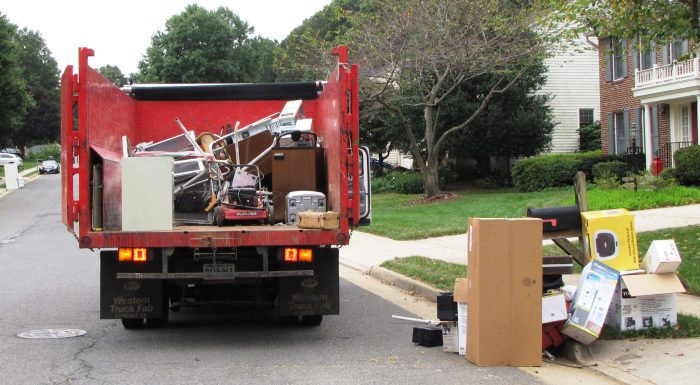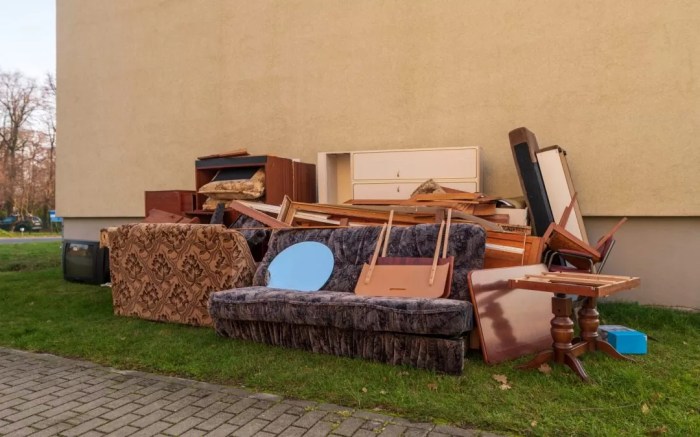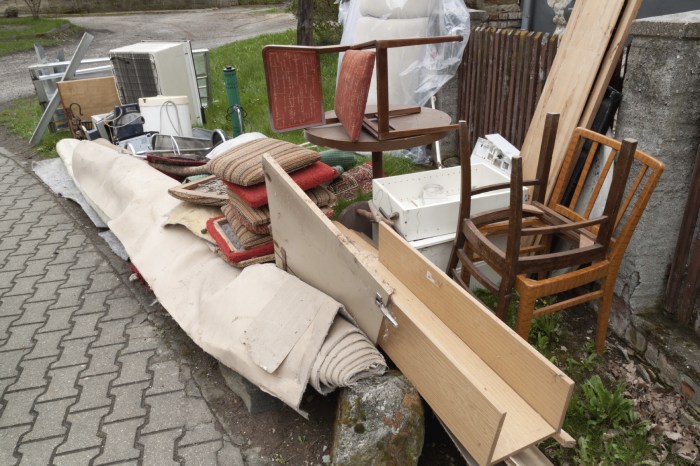Dive into the captivating world of furniture and junk removal, where clutter meets transformation! This industry, brimming with growth and innovation, offers a lifeline to those seeking to declutter their lives and embrace a fresh start. From bulky furniture to everyday waste, furniture and junk removal services provide a solution to every disposal dilemma.
In this comprehensive guide, we’ll delve into the intricate workings of this dynamic industry, exploring its market dynamics, competitive landscape, and the art of customer satisfaction. Join us as we uncover the secrets to successful furniture and junk removal operations, ensuring a seamless and stress-free experience for every client.
Furniture and Junk Removal Industry Overview

The furniture and junk removal industry encompasses the professional removal and disposal of unwanted household items, including furniture, appliances, electronics, and general household clutter. It plays a vital role in maintaining clean and clutter-free living environments and supporting sustainable waste management practices.
The industry has experienced significant growth in recent years, driven by factors such as increasing urbanization, rising disposable incomes, and growing awareness of environmental sustainability. The global furniture and junk removal market was valued at approximately USD 40 billion in 2021 and is projected to reach USD 65 billion by 2027, exhibiting a CAGR of 8.5% during the forecast period.
Types of Furniture and Junk Removal Services
Furniture and junk removal services vary depending on the specific needs of customers. Common types of services include:
- Residential Furniture and Junk Removal:Removal of unwanted items from homes, including furniture, appliances, electronics, and general household clutter.
- Commercial Furniture and Junk Removal:Removal of unwanted items from businesses, offices, and other commercial properties, including office furniture, equipment, and bulk waste.
- Construction and Demolition Debris Removal:Removal of debris generated from construction and demolition projects, such as drywall, wood, metal, and concrete.
- Yard Waste Removal:Removal of organic waste from yards and gardens, including grass clippings, leaves, branches, and other plant debris.
- Appliance and Electronic Recycling:Specialized removal and recycling of appliances and electronics to ensure proper disposal and prevent environmental hazards.
Customer Segmentation and Target Market
Understanding the diverse customer segments in the furniture and junk removal industry is crucial for effective marketing and business success. Different customer groups have distinct needs, preferences, and demographics, requiring tailored approaches to reach and serve them efficiently.
Residential Customers
- Individuals or families who require furniture and junk removal services for home renovations, decluttering, or moving.
- Typically seek convenient, affordable, and reliable services.
- Prefer online booking platforms, local advertising, and word-of-mouth referrals.
Commercial Customers
- Businesses, offices, and organizations that need furniture and junk removal for renovations, relocations, or regular waste disposal.
- Require professional, efficient, and environmentally conscious services.
- Value competitive pricing, flexible scheduling, and customized solutions.
Real Estate Agents and Property Managers
- Professionals who utilize furniture and junk removal services for property preparation, staging, and tenant move-outs.
- Seek reliable, timely, and cost-effective services that enhance property value and appeal.
- Can be reached through industry networking events, online platforms, and referrals.
Construction and Renovation Companies
- Builders and contractors who require furniture and junk removal services as part of construction or renovation projects.
- Need efficient, large-scale removal services that minimize downtime and maximize productivity.
- Prefer long-term partnerships with reliable and experienced providers.
Competitive Landscape

The furniture and junk removal industry is highly competitive, with both local and national players vying for market share. Key players in the industry include 1-800-GOT-JUNK?, Junk King, The Junkluggers, and College HUNKS Hauling Junk & Moving.
1-800-GOT-JUNK? is the largest player in the industry, with a market share of over 50%. The company has a strong brand presence and a wide network of franchisees. Junk King is the second-largest player, with a market share of around 20%. The company is known for its eco-friendly practices and its focus on customer service.
The Junkluggers is a smaller player, with a market share of around 10%. The company is known for its charitable giving and its focus on sustainability. College HUNKS Hauling Junk & Moving is a newer player in the industry, but it has quickly grown to become one of the largest players.
The company is known for its focus on college students and its affordable pricing.
Strengths, Weaknesses, and Opportunities
The competitive landscape of the furniture and junk removal industry is constantly evolving. Key players are constantly innovating and expanding their services in order to gain market share. The following are some of the strengths, weaknesses, and opportunities for different competitors in the industry:
- 1-800-GOT-JUNK?Strengths: Strong brand presence, wide network of franchisees, strong customer service. Weaknesses: High prices, not as eco-friendly as some competitors. Opportunities: Expand into new markets, develop new services.
- Junk KingStrengths: Eco-friendly practices, focus on customer service. Weaknesses: Smaller market share than 1-800-GOT-JUNK?, not as well-known as some competitors. Opportunities: Expand into new markets, develop new services.
- The JunkluggersStrengths: Charitable giving, focus on sustainability. Weaknesses: Smaller market share than 1-800-GOT-JUNK? and Junk King, not as well-known as some competitors. Opportunities: Expand into new markets, develop new services.
- College HUNKS Hauling Junk & MovingStrengths: Focus on college students, affordable pricing. Weaknesses: Smaller market share than 1-800-GOT-JUNK?, Junk King, and The Junkluggers, not as well-known as some competitors. Opportunities: Expand into new markets, develop new services.
Marketing and Sales Strategies: Furniture And Junk Removal
Developing a comprehensive marketing and sales strategy is crucial for the success of a furniture and junk removal business. This strategy should Artikel the target market, marketing channels, and tactics to effectively generate leads, convert prospects, and close deals.
Identifying the target market is the first step in developing an effective marketing strategy. This involves understanding their demographics, psychographics, and specific needs. Once the target market is identified, businesses can tailor their marketing efforts to reach them.
Marketing Channels and Tactics
There are various marketing channels available to reach the target market. These include:
- Online marketing: This includes search engine optimization (), pay-per-click (PPC) advertising, social media marketing, and email marketing.
- Offline marketing: This includes print advertising, direct mail, and local networking events.
The most effective marketing channels will vary depending on the target market and the nature of the business. It is important to experiment with different channels to determine which ones generate the best results.
In the realm of home improvement, furniture and junk removal are intertwined. As you revamp your living spaces, the need to dispose of unwanted items arises. Fortunately, reputable companies like Flanigan Furniture and Mattress offer comprehensive removal services. Their efficient and eco-friendly approach ensures a seamless transition during your home makeover.
Lead Generation and Conversion
Once leads have been generated, the next step is to convert them into paying customers. This can be done through a variety of methods, including:
- Providing valuable content: Offering free resources, such as tips on decluttering or furniture disposal, can help build trust and establish the business as an expert in the industry.
- Nurturing leads: Regularly communicating with leads through email or social media can help keep the business top-of-mind and encourage them to make a purchase.
- Creating a sense of urgency: Offering limited-time promotions or discounts can encourage leads to take action and book a service.
Closing Deals
The final step in the sales process is closing the deal. This involves negotiating the terms of the service, scheduling the appointment, and collecting payment.
By following these steps, furniture and junk removal businesses can develop a comprehensive marketing and sales strategy that will help them reach their target market, generate leads, convert prospects, and close deals.
Operations and Logistics
Establishing a smooth and cost-efficient operational framework is vital for the success of a furniture and junk removal business. This framework should encompass efficient fleet management, effective scheduling, and environmentally responsible waste disposal practices. By optimizing routes, minimizing costs, and prioritizing customer satisfaction, businesses can streamline their operations and ensure a seamless experience for their clients.
Fleet Management
- Determine the optimal fleet size based on service demand and geographic coverage.
- Invest in reliable and well-maintained vehicles to minimize breakdowns and delays.
- Equip vehicles with GPS tracking systems for real-time monitoring and efficient route optimization.
- Establish regular maintenance schedules to ensure vehicle safety and longevity.
- Consider partnering with vehicle rental companies for flexibility and cost savings during peak seasons.
Scheduling
- Implement a robust scheduling system that allows for flexible appointment booking and efficient crew allocation.
- Offer multiple scheduling options to accommodate customer preferences, including online booking, phone calls, and text messages.
- Utilize automated appointment reminders to minimize no-shows and optimize crew utilization.
- Provide real-time updates on crew availability and estimated arrival times to enhance customer communication.
- Consider offering flexible scheduling options, such as same-day or weekend appointments, to meet urgent customer needs.
Waste Disposal Practices
- Establish partnerships with licensed and reputable waste disposal facilities to ensure proper and environmentally responsible waste disposal.
- Implement a waste sorting and recycling program to minimize landfill waste and promote sustainability.
- Educate customers about responsible waste disposal practices and encourage them to separate recyclable materials.
- Obtain necessary permits and licenses for waste disposal activities to comply with local regulations and environmental standards.
- Regularly monitor and review waste disposal practices to identify areas for improvement and ensure compliance.
Pricing and Revenue Models
Establishing a competitive pricing strategy is crucial for maximizing revenue in the furniture and junk removal industry. Different pricing models cater to various customer needs and business objectives.
Pricing models commonly used in the industry include flat rates, hourly rates, and volume-based pricing. Flat rates offer a fixed price for the entire job, while hourly rates charge based on the time taken to complete the task. Volume-based pricing determines the cost based on the quantity or volume of items removed.
Competitive Pricing
To determine competitive pricing, it’s essential to research market rates, analyze competitor pricing, and consider operating costs. Market research provides insights into industry benchmarks and customer expectations. Analyzing competitor pricing helps identify potential price advantages or disadvantages.
Operating costs, including labor, equipment, and transportation, should be carefully calculated to ensure profitability. By considering these factors, businesses can set prices that are both competitive and profitable.
Revenue Maximization
Maximizing revenue involves optimizing pricing strategies and exploring additional revenue streams. Upselling and cross-selling related services, such as deep cleaning or donation assistance, can increase revenue per customer.
Offering discounts for bulk orders or loyalty programs can incentivize repeat business and attract new customers. Additionally, exploring partnerships with other businesses, such as real estate agents or property management companies, can generate referral revenue.
Technology and Innovation
Technology has revolutionized the furniture and junk removal industry, enhancing efficiency, improving customer experience, and driving business growth.
Online booking platforms have streamlined the scheduling process, allowing customers to book appointments conveniently from their devices. Mobile apps provide real-time updates on service status, enabling customers to track their appointments and receive notifications.
GPS Tracking Systems
GPS tracking systems optimize routing and dispatching, reducing travel time and fuel consumption. They also enhance customer confidence by providing real-time visibility into the location of their removal crew.
Environmental Sustainability
The furniture and junk removal industry has a significant impact on the environment due to the large volumes of waste generated. Responsible waste disposal and recycling practices are crucial to minimize this impact.
By implementing sustainable practices, businesses can reduce their carbon footprint and promote environmental conservation.
For those dreading the daunting task of furniture and junk removal, help is just a click away. Consider hiring helpers to move furniture , who can assist with the heavy lifting and ensure a smooth relocation. With their expertise, you can bid farewell to unwanted clutter and embark on a fresh start in your new abode, free from the burden of excess furniture and junk.
Waste Reduction Strategies
- Encourage customers to donate or sell reusable items instead of discarding them.
- Partner with recycling facilities to divert recyclable materials from landfills.
- Use eco-friendly packaging materials and minimize waste during transportation.
Recycling Initiatives
- Establish relationships with scrap metal dealers and recycling centers to process discarded furniture and electronics.
- Educate customers about the importance of recycling and provide clear instructions for sorting materials.
- Invest in recycling equipment to efficiently process and separate recyclable materials.
Carbon Footprint Reduction
- Use fuel-efficient vehicles and optimize routes to reduce emissions.
- Explore alternative fuel sources such as electric or hybrid vehicles.
- Implement employee training programs to promote eco-friendly practices.
Legal and Regulatory Considerations
Navigating the furniture and junk removal industry requires a thorough understanding of the legal and regulatory landscape. Adhering to these requirements ensures compliance, minimizes risks, and protects businesses from potential liabilities.
Compliance with licensing, insurance, and waste disposal regulations is paramount. Licensing requirements vary by jurisdiction, so it’s crucial to research and obtain the necessary permits and licenses to operate legally. Adequate insurance coverage protects businesses from potential accidents, injuries, or property damage during removal operations.
Waste Disposal Regulations
Responsible waste disposal is a legal obligation for furniture and junk removal businesses. Understanding and adhering to waste disposal regulations is essential to minimize environmental impact and avoid penalties. Proper disposal practices include sorting and segregating waste materials, recycling and donating reusable items, and disposing of hazardous materials safely and legally.
Environmental and Safety Standards
Compliance with environmental and safety standards is not only a legal requirement but also a moral obligation. Businesses must implement measures to minimize noise pollution, dust emissions, and other environmental hazards. Ensuring the safety of employees and customers through proper training, protective gear, and safe work practices is also crucial.
Customer Service and Experience
Providing exceptional customer service is paramount in the furniture and junk removal industry. It can make the difference between a one-time transaction and a loyal customer base.
Excellent customer service encompasses prompt responsiveness, clear communication, and a willingness to go the extra mile to meet customer needs. By consistently delivering exceptional service, businesses can foster customer satisfaction and build lasting relationships.
Complaint Handling and Issue Resolution
Handling complaints and resolving issues promptly and effectively is crucial for maintaining customer satisfaction. Establish a clear process for receiving, addressing, and resolving complaints. Ensure that customers have multiple channels for submitting complaints, such as phone, email, and online forms.
Decluttering your home can be a daunting task, especially when it comes to bulky items like furniture. If you’re in the San Diego area, consider furniture removal san diego services to handle the heavy lifting. These professionals will efficiently remove your unwanted furniture and junk, leaving your space refreshed and organized.
When addressing complaints, actively listen to the customer’s concerns, apologize for any inconvenience, and take ownership of the situation. Work collaboratively with the customer to find a mutually acceptable solution. Timely follow-up is essential to ensure the issue has been resolved to the customer’s satisfaction.
Building Customer Loyalty, Furniture and junk removal
Building customer loyalty requires going beyond meeting expectations. Implement strategies such as loyalty programs, personalized communication, and exclusive offers to reward repeat customers. Encourage customer feedback and use it to continuously improve service offerings.
By fostering a customer-centric culture, businesses can create a positive experience that encourages customers to return and recommend the service to others.
Epilogue

As we conclude our journey into the world of furniture and junk removal, it’s evident that this industry is a symphony of efficiency, innovation, and environmental consciousness. By embracing the latest technologies, adhering to ethical disposal practices, and prioritizing customer satisfaction, furniture and junk removal businesses can not only declutter homes and offices but also contribute to a cleaner, more sustainable world.
As this industry continues to evolve, we eagerly anticipate the transformative solutions that lie ahead, empowering us to live clutter-free and embrace a brighter future.
Essential Questionnaire
What are the different types of furniture and junk removal services?
Furniture and junk removal services encompass a wide range, including residential and commercial furniture removal, appliance removal, yard waste removal, and construction debris removal.
How do I choose a reputable furniture and junk removal company?
Look for companies with positive customer reviews, clear pricing, and a commitment to responsible waste disposal practices. Check for licensing and insurance to ensure their legitimacy.
What are the environmental benefits of using furniture and junk removal services?
Furniture and junk removal services contribute to environmental sustainability by diverting waste from landfills, promoting recycling, and reducing carbon emissions through efficient waste disposal practices.